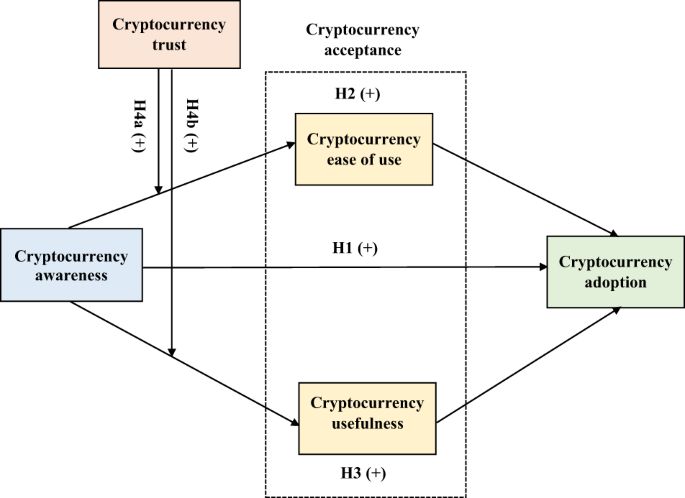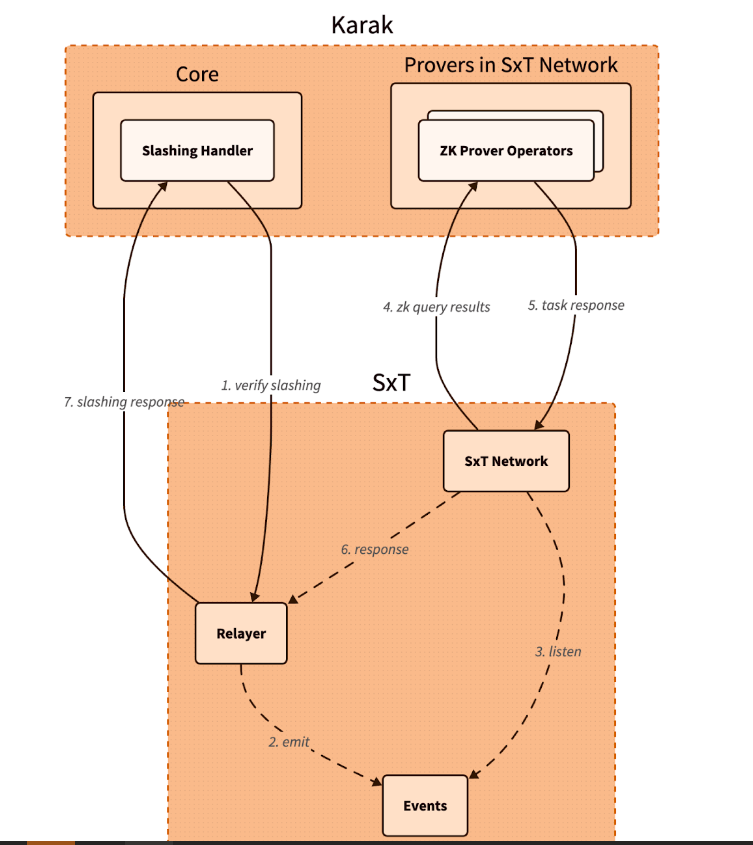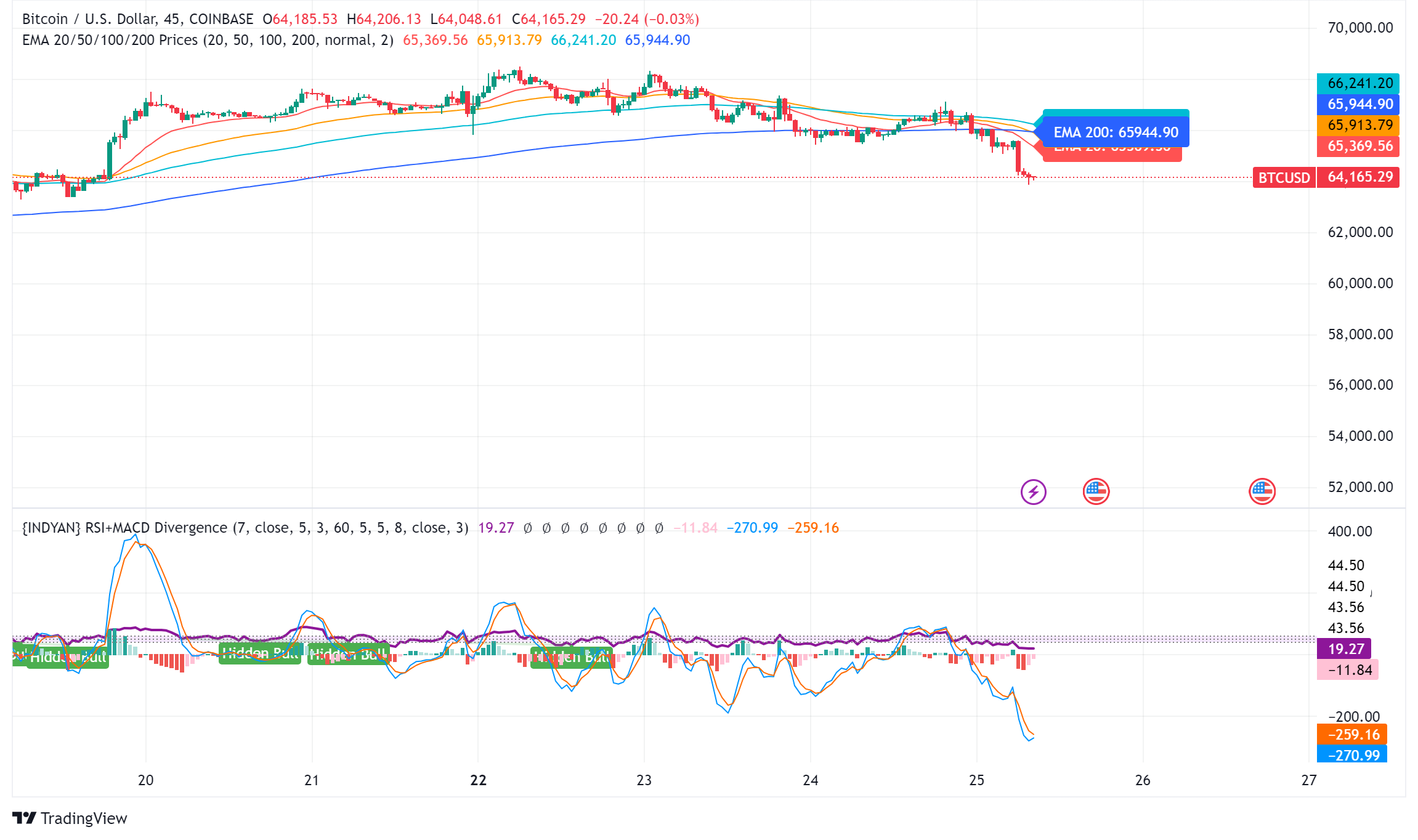Tech
Consapevolezza, accettazione e adozione della criptovaluta: il ruolo della fiducia come pietra angolare

Consapevolezza e adozione della criptovaluta
La consapevolezza gioca un ruolo fondamentale nell’accettazione e nell’adozione delle nuove tecnologie. Risalendo alla teoria della diffusione dell’innovazione, la consapevolezza è considerata la fase iniziale, cruciale per il successo delle successive fasi di adozione (Lu et al., 2022). Basandosi su questa comprensione fondamentale, gli studi che esaminano l’implementazione della tecnologia hanno riaffermato l’associazione positiva tra livelli di consapevolezza e atteggiamenti verso le nuove tecnologie (Arpaci et al., 2023).
La consapevolezza di un individuo racchiude la comprensione dei suoi vantaggi, potenziali svantaggi e metodi pratici per il suo utilizzo (Zou et al., 2023). Di conseguenza, la profondità della consapevolezza di una persona spesso influenza le sue percezioni e, in modo più critico, la sua disponibilità ad adottare. Un parallelo interessante può essere trovato nell’intenzione comportamentale, una metrica che misura la probabilità che gli utenti si impegnino in un’azione specifica. Questa metrica gioca un ruolo decisivo sia nella determinazione ad integrare la criptovaluta nel proprio portafoglio finanziario (Li, 2023). Storicamente, una solida intenzione comportamentale è stata foriera di un’adozione tecnologica di successo, diminuendo il rischio di impegnarsi in innovazioni inadeguate o inferiori (Mizanur e Sloan, 2017; Siagian et al., 2022).
Recenti prove empiriche confermano questa relazione tra consapevolezza e adozione. Ad esempio, (Kakinaka e Umeno, 2022) ha evidenziato che una maggiore consapevolezza ha invariabilmente rafforzato le intenzioni positive verso l’adozione della tecnologia. Questa connessione intrinseca tra consapevolezza cognitiva e risultati comportamentali funge da pietra angolare della nostra indagine. Curiosamente, l’associazione tra consapevolezza e comportamento tecnologico auto-concettualizzati non è meramente aneddotica ma è sostenuta da studi empirici. Ad esempio, (Gupta e Arora, 2020) hanno sottolineato come la consapevolezza tecnologica possa modellare la propensione degli individui ad assimilare la criptovaluta nelle loro attività finanziarie.
Data la crescente enfasi sull’intenzione comportamentale come predittore affidabile dell’adozione della tecnologia (Nadeem et al., 2021) la nostra ricerca approfondisce l’interazione tra la consapevolezza tecnologica e la predisposizione verso asset digitali come la criptovaluta. Alla luce della discussione sopra menzionata e delle prove a sostegno, proponiamo la seguente ipotesi:
H1. La consapevolezza della criptovaluta esercita un’influenza positiva sull’adozione della criptovaluta.
Il ruolo di mediazione della facilità d’uso della criptovaluta
La facilità d’uso rappresenta un fattore fondamentale nel determinare l’adozione di nuove tecnologie (Lim, 2018). Più una tecnologia appare intuitiva e diretta, maggiore è la probabilità della sua accettazione diffusa (Sagheer et al., 2022). Quando l’usabilità di una tecnologia diventa evidente, gli individui sono più propensi a integrarla nella loro routine. Questa nozione è centrale nel TAM, che è stato ampiamente riconosciuto nel settore tecnologico (Sudzina et al., 2023).
L’enfasi sulla facilità d’uso deriva dalla necessità di creare tecnologie che siano accessibili, reattive e adattabili. Quando le persone trovano una tecnologia che soddisfa questi criteri, sono più propense ad adottarla. Si tratta di soddisfare le esigenze dei consumatori senza inondarli di inutili complessità (Nadeem et al., 2021). Sebbene un’eccessiva semplificazione possa occasionalmente scoraggiarne l’utilizzo, gli strumenti efficienti che semplificano i processi generalmente ricevono l’approvazione dei consumatori (Wibasuri, 2022).
Le prove storiche suggeriscono una forte associazione tra facilità d’uso e intenzioni comportamentali verso l’adozione di nuove tecnologie. Ad esempio, Albayati et al. (2020) e Treiblmaier e Sillaber (2021) hanno esplorato questa connessione, sebbene solo Shahzad et al. (2018) ha fornito risultati particolarmente illuminanti. La ricerca attuale si basa su queste basi, indagando la convinzione che la facilità d’uso e l’efficienza delle criptovalute possano migliorare l’esperienza dell’utente e, di conseguenza, i tassi di adozione. Inoltre, questo studio è in linea con la ricerca passata (Siagian et al., 2022), sottolineando la connessione tra la consapevolezza della tecnologia e l’intenzione di adottare la tecnologia. Riconosce il ruolo vitale della facilità d’uso come ponte tra questi elementi.
A tal fine, numerosi studi hanno già evidenziato il profondo impatto della facilità d’uso nel modellare le intenzioni verso nuove integrazioni tecnologiche (Biswas et al., 2021; Chen e Aklikokou, 2020). Tenendo presente questo contesto, la nostra ricerca approfondisce specificamente come il rafforzamento della facilità d’uso possa aprire la strada a una più ampia adozione delle criptovalute. Sulla base della sintesi delle discussioni di cui sopra, proponiamo:
H2. La facilità d’uso della criptovaluta media in modo significativo la relazione tra consapevolezza e adozione della criptovaluta.
Il ruolo di mediazione dell’utilità della criptovaluta
L’utilità riflette la convinzione dei consumatori che l’adozione di una nuova tecnologia migliorerà le loro prestazioni (Davis, 1989; Lim, 2018). Ricerche precedenti sottolineano che i consumatori sono più propensi ad abbracciare la criptovaluta se la ritengono vantaggiosa (Kim et al., 2021). Storicamente, l’utilità è stata un fattore determinante del TAM, sottolineando la sua centralità nella valutazione delle innovazioni tecnologiche (Fagan et al., 2012; Salas, 2020). Il suo ruolo nei sistemi informativi, come facilitare la facilità di adozione della criptovaluta, è infatti sostanziale (Albayati et al., 2020).
Con la crescita delle piattaforme digitali, i consumatori traggono sempre più la loro comprensione dell’utilità di una tecnologia da queste piattaforme. Questo sentimento è in linea con l’enfasi del nostro studio: le piattaforme online fungono da canale attraverso il quale le persone valutano l’utilità della criptovaluta. La decisione di impegnarsi o astenersi dalla tecnologia spesso dipende dalla sua utilità (Theiri et al., 2022). Ricerche precedenti si sono avventurate nell’esame del ruolo dell’utilità nell’influenzare le intenzioni comportamentali, ma i risultati sono stati contrastanti, suggerendo ulteriori indagini (Basuki et al., 2022). Ad esempio, i consumatori spesso appoggiano applicazioni che sono abili, facili da usare e competenti, poiché queste qualità spesso sono correlate all’utilità dello strumento (Granić e Marangunić, 2019). Tuttavia, fattori come il cambiamento del panorama normativo o le incertezze ambientali possono modulare la percezione dei consumatori sull’utilità di una tecnologia (Stocklmayer e Gilbert, 2002). Alcuni studi precedenti, è interessante notare, hanno evidenziato che le inclinazioni dei consumatori erano influenzate più dai valori di intrattenimento che dalla pura utilità, illuminando la natura multiforme del coinvolgimento dei consumatori (Abdul-Rahim et al., 2022).
La letteratura ha costantemente sottolineato la relazione simbiotica tra la consapevolezza della tecnologia e la sua utilità percepita nel plasmare le intenzioni comportamentali. In particolare, Namahoot e Rattanawiboonsom (2022) ha sostenuto che i consumatori hanno trovato utili i pagamenti elettronici, compresi quelli che utilizzano criptovalute. Questa affermazione è rafforzata da altri studi che sottolineano l’impatto diretto della consapevolezza tecnologica sull’intenzione comportamentale attraverso il prisma dell’utilità (Almajali et al., 2022; Sagheer et al., 2022). Degno di nota, un sondaggio condotto da Chen e Aklikokou (2020) ha illuminato il ruolo di mediazione dell’utilità nell’amplificare il comportamento di adozione. Approfondendo questa interazione Schaupp e Festa (2018) ha riflettuto sulla facilità con cui i nuovi arrivati potrebbero adottare la criptovaluta, postulando che coloro che hanno familiarità con le valute digitali sono naturalmente più ricettivi, data l’utilità che ne traggono. Ciò è ulteriormente convalidato dalla ricerca condotta in Cina (Shahzad et al., 2018), che ha stabilito che l’utilità era un fattore determinante per l’adozione della criptovaluta. Alla luce degli approfondimenti e dei risultati sopra menzionati, la nostra ipotesi è articolata come:
H3. L’utilità della criptovaluta media in modo significativo la relazione tra consapevolezza e adozione della criptovaluta.
Il ruolo moderatore della fiducia nelle criptovalute
La fiducia nel contesto delle tecnologie innovative si riferisce al comfort, alla fiducia e alla sicurezza del consumatore nel suo utilizzo (Quan et al., 2023). È una pietra angolare dell’accettazione e dell’adozione, determinando se gli individui si sentono sicuri nell’abbracciare nuove innovazioni (Akther e Nur, 2022). Nel tempo, l’evoluzione delle relazioni sociali ha sottolineato l’importanza di una fiducia costante nell’adozione di nuove tecnologie (Matemba e Li, 2018). Studi, come quelli di Hasan et al. (2022), ha sottolineato che una maggiore fiducia in genere amplifica il tasso di adozione delle tecnologie, soprattutto di quelle nella loro fase nascente. Promuovendo la fiducia nella criptovaluta, il presente studio cerca di aprire la strada a una sua più ampia accettazione e adozione.
Nel commercio digitale, dove l’intangibilità è un dato di fatto, la fiducia è fondamentale. Tale fiducia incoraggia gli utenti a impegnarsi in modo sicuro, riducendo incertezze e riserve (Shin e Rice, 2022). La fiducia reciproca tra utenti e fornitori è essenziale. La fiducia consolida le relazioni utente-fornitore e garantisce una fiducia duratura nelle nuove iniziative imprenditoriali (Sukumaran et al., 2022). In sostanza, le entità affidabili riducono i rischi, spingendo le persone a esplorare e adottare. La ricerca ha dimostrato che coloro che hanno un’inclinazione positiva verso le tecnologie digitali mostrano una maggiore affinità per l’accettazione, dipendente da fattori come la fiducia e le misure di sicurezza associate (Völter et al., 2021). Ciò è confermato da Utz et al. (2022) che ha affermato che la fiducia rafforza l’intenzione degli individui di utilizzare la blockchain, una tecnologia su cui opera la criptovaluta.
Inoltre, la fiducia salvaguarda le informazioni finanziarie e personali dei consumatori, simboleggiando un maggiore livello di fiducia nell’adozione della criptovaluta (Tan e Saraniemi, 2022). Un’osservazione significativa derivante da ricerche passate è che quando la fiducia degli utenti diminuisce, la loro avversione al rischio diminuisce e diventano più suscettibili alle insidie (Sukumaran et al., 2022). Un punto cruciale sollevato da ricercatori come McCloskey (2006), è che la fiducia svolge un ruolo determinante nell’influenzare la percezione dell’utente riguardo alla facilità e all’utilità di una tecnologia. La fiducia, quindi, emerge come il fulcro che modella il comportamento degli utenti, soprattutto per quanto riguarda la facilità d’uso e l’utilità della tecnologia (Albayati et al., 2020; Deebak et al., 2022).
Nel mezzo del discorso prevalente sull’adozione della tecnologia, la fiducia emerge come un fattore determinante. Lo studio attuale approfondisce il ruolo moderatore della fiducia, esaminando la sua influenza sulla relazione tra consapevolezza, accettazione (facilità d’uso, utilità) e adozione della criptovaluta. Il nostro studio cerca di chiarire le sfumature di questa relazione, arricchendo così la comprensione e facendo avanzare il campo. Nello specifico, la fiducia nella criptovaluta è radicata nei protocolli di consenso basati su blockchain, come la prova di partecipazione. Questa fiducia fondamentale aumenta la fiducia delle persone nell’adottare la criptovaluta, con i predittori TAM che fungono da indicatori chiave di questa catena di fiducia. Alla luce di queste considerazioni si propongono le seguenti ipotesi:
H4a. La fiducia nella criptovaluta modera in modo significativo la relazione tra consapevolezza della criptovaluta, facilità d’uso e adozione.
H4b. La fiducia nella criptovaluta modera in modo significativo la relazione tra consapevolezza della criptovaluta, facilità d’uso e adozione.
Il quadro concettuale, che descrive le relazioni ipotizzate, è presentato in Fig. 1. In sostanza, si prevede che la consapevolezza della criptovaluta modellerà positivamente l’adozione della criptovaluta, con la facilità d’uso e l’utilità della criptovaluta che media questa relazione e la fiducia nella criptovaluta che rafforza queste relazioni di mediazione.
Il modello di consapevolezza, accettazione e adozione della criptovaluta.
Tech
Harvard Alumni, Tech Moguls, and Best-Selling Authors Drive Nearly $600 Million in Pre-Order Sales

BlockDAG Network’s history is one of innovation, perseverance, and a vision to push the boundaries of blockchain technology. With Harvard alumni, tech moguls, and best-selling authors at the helm, BlockDAG is rewriting the rules of the cryptocurrency game.
CEO Antony Turner, inspired by the successes and shortcomings of Bitcoin and Ethereum, says, “BlockDAG leverages existing technology to push the boundaries of speed, security, and decentralization.” This powerhouse team has led a staggering 1,600% price increase in 20 pre-sale rounds, raising over $63.9 million. The secret? Unparalleled expertise and a bold vision for the future of blockchain.
Let’s dive into BlockDAG’s success story and find out what the future holds for this cryptocurrency.
The Origin: Why BlockDAG Was Created
In a recent interview, BlockDAG CEO Antony Turner perfectly summed up why the market needs BlockDAG’s ongoing revolution. He said:
“The creation of BlockDAG was inspired by Bitcoin and Ethereum, their successes and their shortcomings.
If you look at almost any new technology, it is very rare that the first movers remain at the forefront forever. Later incumbents have a huge advantage in entering a market where the need has been established and the technology is no longer cutting edge.
BlockDAG has done just that: our innovation is incorporating existing technology to provide a better solution, allowing us to push the boundaries of speed, security, and decentralization.”
The Present: How Far Has BlockDAG Come?
BlockDAG’s presale is setting new benchmarks in the cryptocurrency investment landscape. With a stunning 1600% price increase over 20 presale lots, it has already raised over $63.9 million in capital, having sold over 12.43 billion BDAG coins.
This impressive performance underscores the overwhelming confidence of investors in BlockDAG’s vision and leadership. The presale attracted over 20,000 individual investors, with the BlockDAG community growing exponentially by the hour.

These monumental milestones have been achieved thanks to the unparalleled skills, experience and expertise of BlockDAG’s management team:
Antony Turner – Chief Executive Officer
Antony Turner, CEO of BlockDAG, has over 20 years of experience in the Fintech, EdTech, Travel and Crypto industries. He has held senior roles at SPIRIT Blockchain Capital and co-founded Axona-Analytics and SwissOne. Antony excels in financial modeling, business management and scaling growth companies, with expertise in trading, software, IoT, blockchain and cryptocurrency.
Director of Communications
Youssef Khaoulaj, CSO of BlockDAG, is a Smart Contract Auditor, Metaverse Expert, and Red Team Hacker. He ensures system security and disaster preparedness, and advises senior management on security issues.

advisory Committee
Steven Clarke-Martin, a technologist and consultant, excels in enterprise technology, startups, and blockchain, with a focus on DAOs and smart contracts. Maurice Herlihy, a Harvard and MIT graduate, is an award-winning computer scientist at Brown University, with experience in distributed computing and consulting roles, most notably at Algorand.
The Future: Becoming the Cryptocurrency with the Highest Market Cap in the World
Given its impressive track record and a team of geniuses working tirelessly behind the scenes, BlockDAG is quickly approaching the $600 million pre-sale milestone. This crypto powerhouse will soon enter the top 30 cryptocurrencies by market cap.
Currently trading at $0.017 per coin, BlockDAG is expected to hit $1 million in the coming months, with the potential to hit $30 per coin by 2030. Early investors have already enjoyed a 1600% ROI by batch 21, fueling a huge amount of excitement around BlockDAG’s presale. The platform is seeing significant whale buying, and demand is so high that batch 21 is almost sold out. The upcoming batch is expected to drive prices even higher.

Invest in BlockDAG Pre-Sale Now:
Pre-sale: https://purchase.blockdag.network
Website: https://blockdag.network
Telegram: https://t.me/blockDAGnetwork
Discord: Italian: https://discord.gg/Q7BxghMVyu
No spam, no lies, just insights. You can unsubscribe at any time.
Tech
How Karak’s Latest Tech Integration Could Make Data Breaches Obsolete

- Space and Time uses zero-knowledge proofs to ensure secure and tamper-proof data processing for smart contracts and enterprises.
- The integration facilitates faster development and deployment of Distributed Secure Services (DSS) on the Karak platform.
Karak, a platform known for its strong security capabilities, is enhancing its Distributed Secure Services (DSS) by integrating Space and Time as a zero-knowledge (ZK) coprocessor. This move is intended to strengthen trustless operations across its network, especially in slashing and rewards mechanisms.
Space and Time is a verifiable processing layer that uses zero-knowledge proofs to ensure that computations on decentralized data warehouses are secure and untampered with. This system enables smart contracts, large language models (LLMs), and enterprises to process data without integrity concerns.
The integration with Karak will enable the platform to use Proof of SQL, a new ZK-proof approach developed by Space and Time, to confirm that SQL query results are accurate and have not been tampered with.
One of the key features of this integration is the enhancement of DSS on Karak. DSS are decentralized services that use re-staked assets to secure the various operations they provide, from simple utilities to complex marketplaces. The addition of Space and Time technology enables faster development and deployment of these services, especially by simplifying slashing logic, which is critical to maintaining security and trust in decentralized networks.

Additionally, Space and Time is developing its own DSS for blockchain data indexing. This service will allow community members to easily participate in the network by running indexing nodes. This is especially beneficial for applications that require high security and decentralization, such as decentralized data indexing.
The integration architecture follows a detailed and secure flow. When a Karak slashing contract needs to verify a SQL query, it calls the Space and Time relayer contract with the required SQL statement. This contract then emits an event with the query details, which is detected by operators in the Space and Time network.
These operators, responsible for indexing and monitoring DSS activities, validate the event and route the work to a verification operator who runs the query and generates the necessary ZK proof.
The result, along with a cryptographic commitment on the queried data, is sent to the relayer contract, which verifies and returns the data to the Karak cutter contract. This end-to-end process ensures that the data used in decision-making, such as determining penalties within the DSS, is accurate and reliable.
Karak’s mission is to provide universal security, but it also extends the capabilities of Space and Time to support multiple DSSs with their data indexing needs. As these technologies evolve, they are set to redefine the secure, decentralized computing landscape, making it more accessible and efficient for developers and enterprises alike. This integration represents a significant step towards a more secure and verifiable digital infrastructure in the blockchain space.
Website | X (Twitter) | Discord | Telegram
No spam, no lies, just insights. You can unsubscribe at any time.
Tech
Cryptocurrency Payments: Should CFOs Consider This Ferrari-Approved Trend?

Iconic Italian luxury carmaker Ferrari has announced the expansion of its cryptocurrency payment system to its European dealer network.
The move, which follows a successful launch in North America less than a year ago, raises a crucial question for CFOs across industries: Is it time to consider accepting cryptocurrency as a form of payment for your business?
Ferrari’s move isn’t an isolated one. It’s part of a broader trend of companies embracing digital assets. As of 2024, we’re seeing a growing number of companies, from tech giants to traditional retailers, accepting cryptocurrencies.
This change is determined by several factors:
- Growing mainstream adoption of cryptocurrencies
- Growing demand from tech-savvy and affluent consumers
- Potential for faster and cheaper international transactions
- Desire to project an innovative brand image
Ferrari’s approach is particularly noteworthy. They have partnered with BitPay, a leading cryptocurrency payment processor, to allow customers to purchase vehicles using Bitcoin, Ethereum, and USDC. This satisfies their tech-savvy and affluent customer base, many of whom have large digital asset holdings.
Navigating Opportunities and Challenges
Ferrari’s adoption of cryptocurrency payments illustrates several key opportunities for companies considering this move. First, it opens the door to new customer segments. By accepting cryptocurrency, Ferrari is targeting a younger, tech-savvy demographic—people who have embraced digital assets and see them as a legitimate form of value exchange. This strategy allows the company to connect with a new generation of affluent customers who may prefer to conduct high-value transactions in cryptocurrency.
Second, cryptocurrency adoption increases global reach. International payments, which can be complex and time-consuming with traditional methods, become significantly easier with cryptocurrency transactions. This can be especially beneficial for businesses that operate in multiple countries or deal with international customers, as it potentially reduces friction in cross-border transactions.
Third, accepting cryptocurrency positions a company as innovative and forward-thinking. In today’s fast-paced business environment, being seen as an early adopter of emerging technologies can significantly boost a brand’s image. Ferrari’s move sends a clear message that they are at the forefront of financial innovation, which can appeal to customers who value cutting-edge approaches.
Finally, there is the potential for cost savings. Traditional payment methods, especially for international transactions, often incur substantial fees. Cryptocurrency transactions, on the other hand, can offer lower transaction costs. For high-value purchases, such as luxury cars, these savings could be significant for both the business and the customer.
While the opportunities are enticing, accepting cryptocurrency payments also presents significant challenges that businesses must address. The most notable of these is volatility. Cryptocurrency values can fluctuate dramatically, sometimes within hours, posing potential risk to businesses that accept them as payment. Ferrari addressed this challenge by implementing a system that instantly converts cryptocurrency received into traditional fiat currencies, effectively mitigating the risk of value fluctuations.
Regulatory uncertainty is another major concern. The legal landscape surrounding cryptocurrencies is still evolving in many jurisdictions around the world. This lack of clear and consistent regulations can create compliance challenges for companies, especially those operating internationally. Companies must remain vigilant and adaptable as new laws and regulations emerge, which can be a resource-intensive process.
Implementation costs are also a significant obstacle. Integrating cryptocurrency payment systems often requires substantial investment in new technology infrastructure and extensive staff training. This can be especially challenging for small businesses or those with limited IT resources. The costs are not just financial; a significant investment of time is also required to ensure smooth implementation and operation.
Finally, security concerns loom large in the world of cryptocurrency transactions. While blockchain technology offers some security benefits, cryptocurrency transactions still require robust cybersecurity measures to protect against fraud, hacks, and other malicious activity. Businesses must invest in robust security protocols and stay up-to-date on the latest threats and protections, adding another layer of complexity and potential costs to accepting cryptocurrency payments.
Strategic Considerations for CFOs
If you’re thinking of following in Ferrari’s footsteps, here are the key factors to consider:
- Risk Assessment: Carefully evaluate potential risks to your business, including financial, regulatory, and reputational risks.
- Market Analysis: Evaluate whether your customer base is significantly interested in using cryptocurrencies for payments.
- Technology Infrastructure: Determine the costs and complexities of implementing a cryptographic payment system that integrates with existing financial processes.
- Regulatory Compliance: Ensure that cryptocurrency acceptance is in line with local regulations in all markets you operate in. Ferrari’s gradual rollout demonstrates the importance of this consideration.
- Financial Impact: Analyze how accepting cryptocurrency could impact your cash flow, accounting practices, and financial reporting.
- Partnership Evaluation: Consider partnering with established crypto payment processors to reduce risk and simplify implementation.
- Employee Training: Plan comprehensive training to ensure your team is equipped to handle cryptocurrency transactions and answer customer questions.
While Ferrari’s adoption of cryptocurrency payments is exciting, it’s important to consider this trend carefully.
A CFO’s decision to adopt cryptocurrency as a means of payment should be based on a thorough analysis of your company’s specific needs, risk tolerance, and strategic goals. Cryptocurrency payments may not be right for every business, but for some, they could provide a competitive advantage in an increasingly digital marketplace.
Remember that the landscape is rapidly evolving. Stay informed about regulatory changes, technological advancements, and changing consumer preferences. Whether you decide to accelerate your crypto engines now or wait in the pit, keeping this payment option on your radar is critical to navigating the future of business transactions.
Was this article helpful?
Yes No
Sign up to receive your daily business insights
Tech
Bitcoin Tumbles as Crypto Market Selloff Mirrors Tech Stocks’ Plunge

The world’s largest cryptocurrency, Bitcoin (BTC), suffered a significant price decline on Wednesday, falling below $65,000. The decline coincides with a broader market sell-off that has hit technology stocks hard.
Cryptocurrency Liquidations Hit Hard
CoinGlass data reveals a surge in long liquidations in the cryptocurrency market over the past 24 hours. These liquidations, totaling $220.7 million, represent forced selling of positions that had bet on price increases. Bitcoin itself accounted for $14.8 million in long liquidations.
Ethereum leads the decline
Ethereal (ETH), the second-largest cryptocurrency, has seen a steeper decline than Bitcoin, falling nearly 8% to trade around $3,177. This decline mirrors Bitcoin’s price action, suggesting a broader market correction.
Cryptocurrency market crash mirrors tech sector crash
The cryptocurrency market decline appears to be linked to the significant losses seen in the U.S. stock market on Wednesday. Stock market listing The index, heavily weighted toward technology stocks, posted its sharpest decline since October 2022, falling 3.65%.
Analysts cite multiple factors
Several factors may have contributed to the cryptocurrency market crash:
- Tech earnings are underwhelming: Earnings reports from tech giants like Alphabet are disappointing (Google(the parent company of), on Tuesday, triggered a sell-off in technology stocks with higher-than-expected capital expenditures that could have repercussions on the cryptocurrency market.
- Changing Political Landscape: The potential impact of the upcoming US elections and changes in Washington’s policy stance towards cryptocurrencies could influence investor sentiment.
- Ethereal ETF Hopes on the line: While bullish sentiment around a potential U.S. Ethereum ETF initially boosted the market, delays or rejections could dampen enthusiasm.
Analysts’ opinions differ
Despite the short-term losses, some analysts remain optimistic about Bitcoin’s long-term prospects. Singapore-based cryptocurrency trading firm QCP Capital believes Bitcoin could follow a similar trajectory to its post-ETF launch all-time high, with Ethereum potentially converging with its previous highs on sustained institutional interest.
Rich Dad Poor Dad Author’s Prediction
Robert Kiyosaki, author of the best-selling Rich Dad Poor Dad, predicts a potential surge in the price of Bitcoin if Donald Trump is re-elected as US president. He predicts a surge to $105,000 per coin by August 2025, fueled by a weaker dollar that is set to boost US exports.
BTC/USD Technical Outlook
Bitcoin price is currently trading below key support levels, including the $65,500 level and the 100 hourly moving average. A break below the $64,000 level could lead to further declines towards the $63,200 support zone. However, a recovery above the $65,500 level could trigger another increase in the coming sessions.
-

 News11 months ago
News11 months agoVolta Finance Limited – Director/PDMR Shareholding
-

 News11 months ago
News11 months agoModiv Industrial to release Q2 2024 financial results on August 6
-

 News11 months ago
News11 months agoApple to report third-quarter earnings as Wall Street eyes China sales
-

 News11 months ago
News11 months agoNumber of Americans filing for unemployment benefits hits highest level in a year
-

 News1 year ago
News1 year agoInventiva reports 2024 First Quarter Financial Information¹ and provides a corporate update
-

 News1 year ago
News1 year agoLeeds hospitals trust says finances are “critical” amid £110m deficit
-

 DeFi1 year ago
DeFi1 year ago🏴☠️ Pump.Fun operated by Insider Exploit
-

 Markets1 year ago
Markets1 year agoWhale Investments in Bitcoin Hit $100 Billion in 2024, Fueling Insane Investor Optimism ⋆ ZyCrypto
-

 Tech1 year ago
Tech1 year agoBitcoin’s Correlation With Tech Stocks Is At Its Highest Since August 2023: Bloomberg ⋆ ZyCrypto
-

 Tech1 year ago
Tech1 year agoEverything you need to know
-

 News11 months ago
News11 months agoStocks wobble as Fed delivers and Meta bounces
-

 Markets1 year ago
Markets1 year agoCrazy $3 Trillion XRP Market Cap Course Charted as Ripple CEO Calls XRP ETF “Inevitable” ⋆ ZyCrypto





